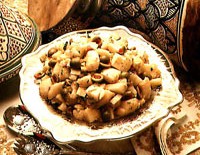A Victorian-Era, Daughter of a British Earl, Muslim Convert Woman?
By Ruqyah Sweidan / Arab America Contributing Writer
As of 2018, just under four million Muslims are residing in Britain. While many Muslims as well as their descendants are immigrants statistics have shown growing numbers of white British individuals converting to Islam. The message of Islam has spread organically. Although now it occurs at a faster pace, the world has become a smaller place, and there is more interaction among all walks of life. However, how would someone – a woman – in the Victorian era of Britain become accurately educated on Islam? How did she secure her visit to Mecca? All these questions will be answered in this article.
From Lady Evelyn to Lady Zainab
Lady Evelyn Murray was born in Edinburgh in 1867. As a child, her father took her family to North Africa every winter. In Algiers and Cairo, she learned to speak Arabic. Lady Evelyn also enjoyed the company of the local children, visited mosques and was tended to by Muslim nannies. She kept a journal of her adventures. One was published as the book, “Wayfarers in the Libyan Desert”, which was about her travels in Egypt in 1911. Lady Evelyn later claimed that she had no recollection of when she first became Muslim. She felt that she had always been. The first time she met the Pope was the first time she publicly declared herself as a Muslim.
“Some years went by and I happened to be in Rome staying with some Italian friends when my host asked if I would like to visit the Pope. Of course, I was thrilled…. When His Holiness suddenly addressed me, asking if I was a Catholic, I was taken aback for a moment and then replied that I was a Moslem. What possessed me I don’t pretend to know, as I had not given a thought to Islam for many years. A match was lit and I then and there determined to read up and study the Faith.”
Lady Evelyn Murray in her journals
Her Spiritual Journey
Lady Evelyn was friends with a fellow convert to Islam, Marmaduke Pickthall, who translated the Qur’an to English, from 1915. Letters from the Lady’s friends in North Africa and Syria referred to her as ‘our sister in Islam’. Moreover, Lady Evelyn changed her name to Zainab. After declaring her faith to her family, her relationship with them became strained. She and her husband separated in 1922. Zainab made the best of her situation by using her wealth attained from her divorce settlement to continue her travels. An adventurous Scot at heart, she traveled alone even while she was still married. Her visits to the Arab region were said to be the preface of Princess Alice’s – Queen Victoria’s longest-living granddaughter – visit with her husband across Saudi Arabia.
In 1929, Zainab began her pursuit of performing Hajj. She needed to write to the prince Abdul Aziz of Saudi Arabia to get permission to go. Zainab was sixty-five years old when she received approval in 1933. She became the first Muslim woman born in Britain to perform Hajj. While there, she wrote a book of her accounts, “Pilgrimage to Mecca”. It details a deeply spiritual sense of belonging and utter euphoria. The publication was positively received by the British press. The critical acclaim was mostly for Zainab’s raw description of the great anxiety she felt while waiting to get in, being overwhelmed by the heart of Islam, and finally feeling emotionally complete.
Muslims of the Victorian Era
There are more converts in the Victorian era than people might think. Many Europeans have traveled and lived abroad, as military personnel, merchants, as well as thousands of others living there in the colonialist times. Back then, these converts were mainly regarded as eccentric and educated by the local population. On the other hand, today’s converts are seen as brainwashed. Hence, we learn that non-Muslims used to be more curious and did not fear Islam, which is the opposite of the rhetoric across Europe today. Zainab must have experienced difficulties in her new life as a wide Muslim community in Britain did not exist then as it does today.
Zainab’s Legacy
Another question remains. Why has this courageous, intelligent woman’s history nearly disappeared within the Western understanding of Islam? There are several reasons. British society likely regarded Zainab as eccentric and snobbish. Academics and the theocracy might have also thought that Zainab was not serious and was perhaps traveling and practicing a foreign religion for effect rather than reality. Furthermore, colonialist ideals perpetuated the belief that Westerners living in the Arab region could not possibly have had access to a good education. Therefore, European converts to Islam were not on the correct path. The British establishment additionally regarded Zainab’s books as fanciful travel writing. Despite this rhetoric, Zainab was very much part of that post-First World War era of feminism.
Zainab died thirty years after she performed Hajj. She was buried in accordance with her faith in a remote and beautiful area within her family’s estate. Her gravestone reads: “Allah is the Light of the Heavens and the Earth.” Her funeral took place in the grip of Scottish winter. A lone piper, shivering, played MacCrimmon’s Lament while an imam, who had traveled from London, performed the burial rituals and recited verses from the Quran. Lady Zainab leaves behind a remarkable legacy of vulnerable and heartfelt writing, an adventurous outlook on life and a faithful conviction.
Check out Arab America Blog here!


